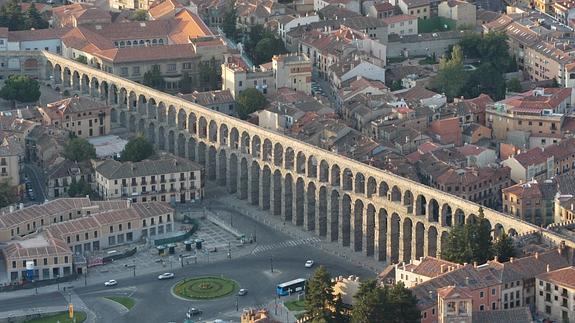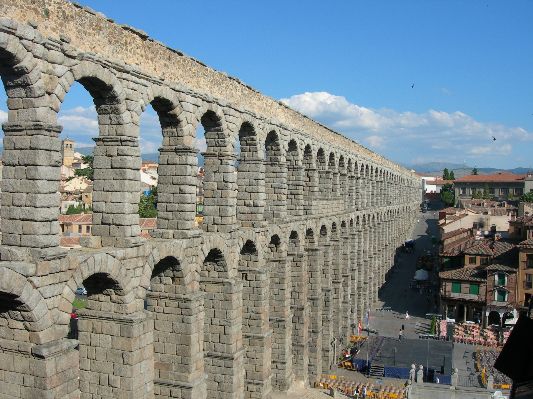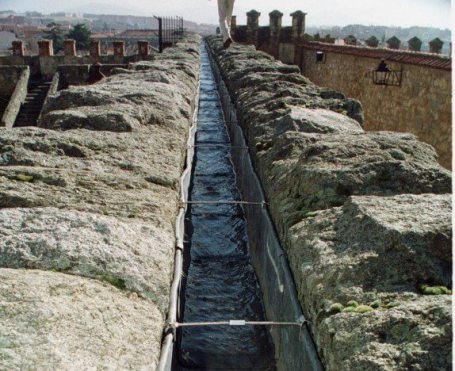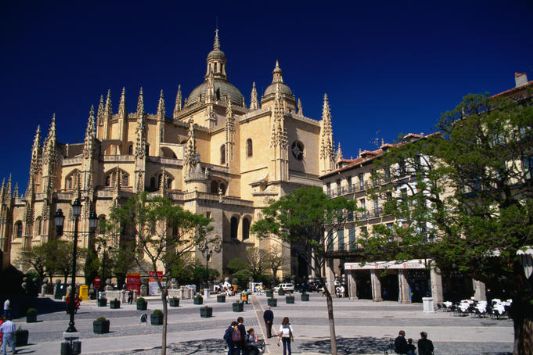Segovia is the result of very complex history. Its neighbourhoods, streets, and houses are laid out in accordance with a social structure in which hierarchy was overshadowed by belonging to one of the different cultural communities. Moors, Christians and Jews coexisted for a long time in this medieval city and worked together during the 16th century “construction boom”. Everything from domestic architecture to the great religious and military structures, can be found in Segovia in a broad range of construction techniques and styles.
The Aqueduct of Segovia, the symbol of the city, is the best known of these civil engineering feats owing to its monumentality, to its excellent state of conservation, and in particular to its location in one of the most beautiful urban sites in the world. Frontinus described the aquaducts as 'the most solemn testimony of the Empire.'

It was probably built during the Flavio period, between the late 1st and early 2nd centuries, when Vespasiano and Trajano were emperors. This magnificent work of engineering is still in excellent condition. The hydraulic engineers who tapped the waters of the Río Frío in the Sierra de Guadarrama to bring them 18km to Segovia via a canal with an average gradient of 1% ran into no natural obstacle more challenging than the crossing of the valley of the Río Clamores at the end of the course. In order to reach the rocky contrefort on which the city was perched they had to erect an enormous construction of masonry 813 m in length, consisting of four straight segments and two superimposed arcades borne by 128 pillars. Its 20,400 stone blocks are neither cemented nor stuck together by any substance, and they remain as a solid perfect block to this day. The maximum height of the structure is on the Azoguejo Square at 28.10 m and a total of 166 arches.

This colossal structure is undocumented. However, the profile of the arcade and the construction technique used show comparisons with the Aqua Claudia in Rome, a canal built between AD 38 and 52. Moreover, excavation carried out at the foot of the piers appears to corroborate a date of roughly AD 50.
 Following its restoration, which took place after 1484 on the initiative of the Catholic Kings (Los Reyes Católicos), the aqueduct was always used and well maintained. The most serious damage which it suffered occurred in the last century: the replacement in 1929-30 of the 16th-century stone conduit with a cement canal, the stone conduit having earlier replaced a wooden one; disintegration of the masonry owing to the effects of vibration caused by traffic of heavy trucks; decay of the stone caused by gas pollutants. This physical-chemical damage results principally from a poorly planned urban development policy which has destroyed the monument's surroundings by the building of parking lots, large thoroughfares and slip roads which detract from the beauty of the aqueduct and hinder its proper conservation.
Following its restoration, which took place after 1484 on the initiative of the Catholic Kings (Los Reyes Católicos), the aqueduct was always used and well maintained. The most serious damage which it suffered occurred in the last century: the replacement in 1929-30 of the 16th-century stone conduit with a cement canal, the stone conduit having earlier replaced a wooden one; disintegration of the masonry owing to the effects of vibration caused by traffic of heavy trucks; decay of the stone caused by gas pollutants. This physical-chemical damage results principally from a poorly planned urban development policy which has destroyed the monument's surroundings by the building of parking lots, large thoroughfares and slip roads which detract from the beauty of the aqueduct and hinder its proper conservation.
